

New Health Concerns. Water in situ. The Congressional Debate Over What Makes Food "Natural" Food Safety. Bacillus thuringiensis: Profile of a bacterium - Basic info. Apr 4, 2007 Basic info Print Send.

Modern Meadow. See Global Research - 5 Gyres - Understanding Plastic Pollution Through Exploration, Education, and Action - 5 Gyres – Understanding Plastic Pollution Through Exploration, Education, and Action. The research we are doing The 5 Gyres team collects samples of the oceans surface to quantity the mass, size, color and type of plastic pollution floating in the gyres.
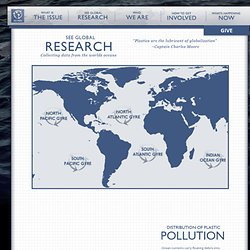
Shrimp's Dirty Secrets: Why America's Favorite Seafood Is a Health and Environmental Nightmare. January 24, 2010 | Like this article?
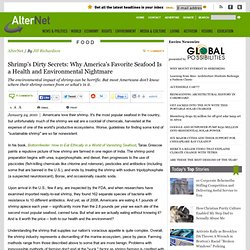
Join our email list: Stay up to date with the latest headlines via email. Americans love their shrimp. It's the most popular seafood in the country, but unfortunately much of the shrimp we eat are a cocktail of chemicals, harvested at the expense of one of the world's productive ecosystems. 8 Foods Even The Experts Won’t Eat. By April McCarthy.

Originally published on Preventdisease.com. Food scientists are shedding light on items loaded with toxins and chemicals–and simple swaps for a cleaner diet and supersized health. Experts from different areas of specialty explain why they won’t eat these eight foods. Food Sovreignty: A Critical Dialogue_2013. As You Sow: Environmental Health - Nanomaterials. It is reported that nanotechnology is already being used in food and food related products but, due to the food industry's lack of transparency on the issue, concrete information about whether, and how much, nanomaterials are being used in food products is difficult to obtain.
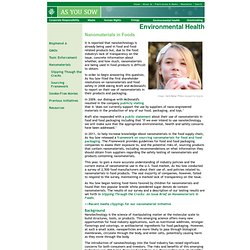
As You Sow: Issue Brief on Nanomaterials. Slipping Through the Cracks is designed to inform companies, investors, and consumers about the emerging use of engineered nanomaterials in food and food related products.

It highlights the potential risks of nanotechnology for companies who are knowingly or unknowingly using it in their products and for public health. As You Sow and other leading investors surveyed 25,000 food manufacturers and tested a range of popular donuts; the results of both inquiries proved that nanomaterials are currently being used in food products. To test more food products for the presence of nanomaterials, As You Sow has also launched a crowdfunding campaign. Food Intelligence for Families Who Eat. EWG's 2013 Shopper's Guide to Pesticides in Produce™ Finding Healthier Food People don't want to consume pesticides with their food and water.
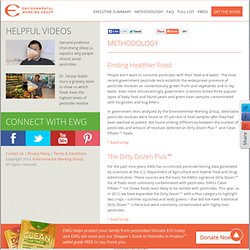
The most recent government pesticide tests establish the widespread presence of pesticide residues on conventionally-grown fruits and vegetables and in tap water. Even more disconcertingly, government scientists tested three popular types of baby food and found pears and green bean samples contaminated with fungicides and bug killers. In government tests analyzed by the Environmental Working Group, detectable pesticide residues were found on 67 percent of food samples after they had been washed or peeled. We found striking differences between the number of pesticides and amount of residues detected on Dirty Dozen Plus™ and Clean Fifteen™ foods. How Your Chicken Dinner Is Creating a Drug-Resistant Superbug - Maryn McKenna. Continuing to treat urinary tract infections as a short-term, routine ailment rather than a long-term food safety issue risks turning the responsible bacteria into a major health crisis. kusabi/Flickr Adrienne LeBeouf recognized the symptoms when they started.
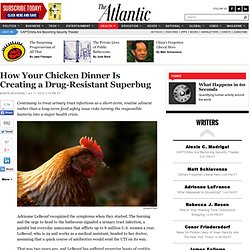
The burning and the urge to head to the bathroom signaled a urinary tract infection, a painful but everyday annoyance that afflicts up to 8 million U.S. women a year. LeBeouf, who is 29 and works as a medical assistant, headed to her doctor, assuming that a quick course of antibiotics would send the UTI on its way. On The Run: How Families Struggle To Eat Well And Exercise. Fast%20Food%20Nation. United States Accused of Planting Avian Flu in Recent H7N9 Outbreak. Janet C.

PhelanActivist Post Amidst allegations by a highly placed Colonel in the Chinese army that the U.S. has released a bioweapon in Mainland China, concerns are ramping up that this year's version of the avian flu, H7N9, may turn into a major pandemic. The last few years have seen several false alarms on the pandemic front. Neither the bird flu of 2004 nor the swine flu of 2009-2010 ended up being of much concern, although agencies from the WHO on down certainly created quite a flurry around both of these flu bugs. H7N9 has already shown itself to have a high mortality rate, higher in fact than the Spanish flu of 1918, which caused 50 million deaths worldwide.
According to Keiji Fukuda, WHO's assistant director-general for health, security and the environment, "This is definitely one of the most lethal influenza viruses that we have seen so far. " Fast Food, Poverty Wages: The Public Cost of Low-Wage Jobs in the Fast-Food Industry. October 15, 2013, by Sylvia Allegretto, Marc Doussard, Dave Graham-Squire, Ken Jacobs, Dan Thompson and Jeremy Thompson » Full Report » California Legislative Hearing Testimony » Press Release » Press Coverage Nearly three-quarters (73 percent) of enrollments in America's major public benefits programs are from working families.

Conflictpalmoil. Ractopamine. Ractopamine. The ban on U.S. pork and beef exports to Russia over ractopamine is costly for American producers, but not as much as was recently reported by the U.S. Ambassador. U.S. Ambassador to Russia Michael McFaul told a Moscow business newspaper that the year-old ban had cost America’s pork and beef industries $4-5 billion. The ban… Continue Reading A new U.S. The sale of Smithfield Foods, the United States’ largest pork producer, to Shuanghui International, China’s largest meat company, raises new questions about the future of ractopamine, a controversial growth-promoting drug that is widely used in U.S. pork production and has long been the subject of trade disputes.
The Safety of Polyethylene Terephthalate (PET) » en español For more than 100 years, plastic products have revolutionized the way we live. Polyethylene terephthalate, or PET, is a particularly notable example. FAQs: The Safety of Food Containers Made with Polycarbonate Plastic. » en español Polycarbonate plastic has been studied and tested for nearly 50 years, and its use in products that come in contact with food is regulated by the U.S. Food and Drug Administration (FDA) as well as governmental bodies worldwide. A raw material used in polycarbonate plastics, bisphenol A (BPA), has been the subject of news reports questioning its safety. Extensive safety data on BPA show that polycarbonate plastic can be used safely in consumer products.
The Safety of Beverages in Plastic Bottles. BEVERAGES | April/May 2009 By Jill Culora With bisphenol A (BPA) and polyethylene terephthalate (PET) consistently in the mass media with regard to beverage packaging, beverage processors must manage the vast amount of misinformation that abounds and maintain strict standards of beverage safety. While cognizant of consumer concerns, beverage manufacturers must insist on transparency and continue to reassure consumers about product safety.
Below are common questions that beverage and food manufacturers must answer to reassure customers of the safety of their products. KSR2 Mutations Are Associated with Obesity, Insulin Resistance, and Impaired Cellular Fuel Oxidation. HB2 Bromine Precursor – A New Antimicrobial Intervention - Birko Food Processing Plant Cleaning Chemicals, Sanitation Chemicals and Delivery Equipment.
A Diet that Fits Your Genes. Avian Flu - FAO's Animal Production and Health Division - home. Food and Agriculture Organization of the United Nations: Hunger Portal. Coalition of Immokalee Workers. $2.4M fund to develop products from bio-based feedstocks. Thanks to a $1.09 million grant from the Michigan Strategic Fund, plus matching funds from Michigan State University (MSU), several bio-based MSU research projects will be fast-tracked for commercial development over the next three years.
La Coca-colisation nuit gravement à la santé. Famines au XXIe siècle. Tell Congress to Stop the Corporate Farm Bill Boondoggle! Every 5 years, Congress passes a Food and Farm bill that dictates food and agriculture policy for decades to come. This is the single most important piece of legislation that determines what Americans, and many people around the world, eat on a daily basis. Today, voting on vital improvements to the House Farm Bill! When it comes to food, technology won’t save us. Modern wheat a "perfect, chronic poison," doctor says. (CBS News) Modern wheat is a "perfect, chronic poison," according to Dr. Hormonal effects of soy in premenopausal women and men. [J Nutr. 2002. IUF.SIB.Nutrigenomics.
World of Food Science: Volume 14 - Education. Tests Found High Benzene Contamination of Diet Soda - 79 Percent of Samples Above Drinking Water Limit. Why a Stick of Chewing Gum is More Harmful To Your Health Than Anything You Eat. People do not typically ingest gum, so they pay very little attention to its ingredients. The assumption is that if the gum is not swallowed, then the ingredients should not be a concern.
However, the ingredients in gum travel into the blood stream faster and in higher concentrations than food ingredients, because they absorb directly through the walls of the mouth, and these ingredients do not undergo the normal filtration process of digestion. Gum is typically the most toxic product in supermarkets that is intended for internal use, and it is likely to kill any pet that eats it. Everything Added to Food in the United States (EAFUS) Miami couple forced to rip out 17-year-old veggie garden in their front yard.
E-numbers. Codex Alimentarius Food Additives. The Sad State Of School Lunch In The U.S. (PHOTOS) Causes of Foodborne Illness: Bad Bug Book > CFSAN - Bad Bug Book - pH Values of Various Foods. Check your freezer: 22,737 lbs of beef recalled. Persistence of Salmonella and E. coli on th... [J Environ Health. 2013. E coli test kit. The big 9 foodborne illnesses: botulism, campylobacter, E. coli, listeria, BSE, norovirus, salmonella, staph, and trichinosis. The Shelf of Life of Foods [Infographic] The Shelf Life of Food. The 9 nastiest things in your supermarket. Steak made from human poop passes taste test. Human Tissue Found in Meats - But Eating It Is "No Threat" 8 creepy mystery ingredients in fast food. McDonald’s Invests $6.5 Million in Sustainable Guatemala Coffee. Retail Food Protection > Growing Sprouts in Retail Food Establishment - CFP Issues 02-III-01 and 04-III-012.
GMO's, Good for Whom? Seeds at Risk in AgroBusiness. Invisible Threats. We Are What We Eat. Health References.